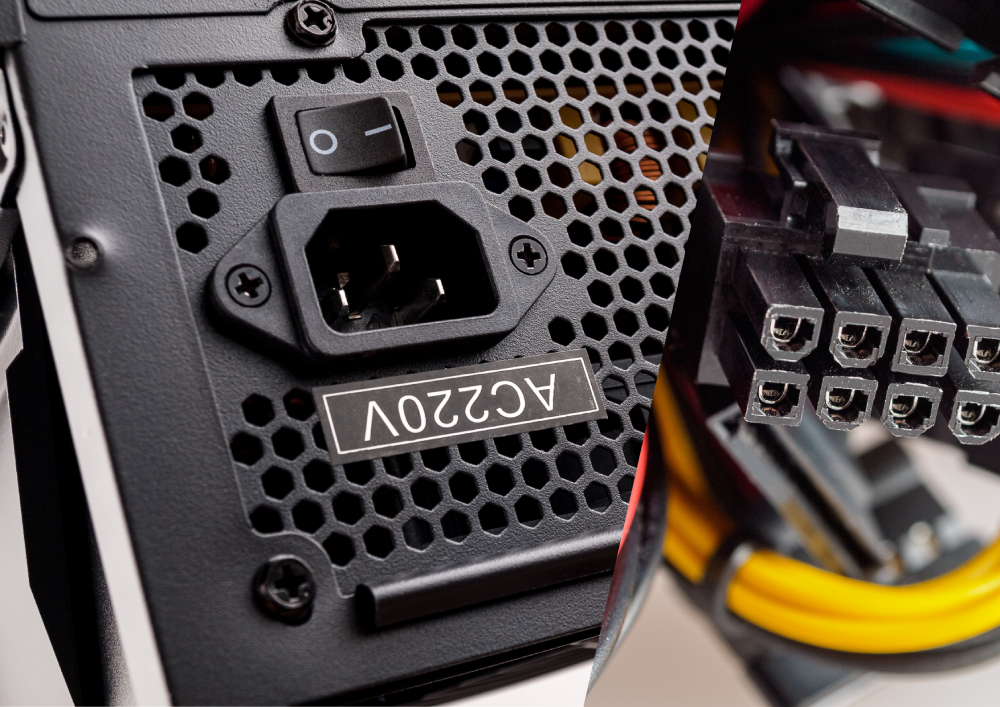
How to choose the right power supply for your PC
Why the power supply (PSU) is critical to PC performance
When we build or buy a computer, the focus is often on the processor, graphics card or RAM. However, the power supply (PSU) is one of the most important components of the system. It supplies power to all parts and directly influences the stability and lifespan of the PC.
Choosing the wrong or poor-quality source can lead to errors, instability, or even component failure. That’s why it’s vital to understand how a power supply works, what types exist, and how to choose it correctly for your needs.
1. Connectivity: the cables that power the system
Any modern power supply comes with several types of cables, each with a specific role.
Here are the main connections you need to recognize:
- 24-pin (motherboard): powers the motherboard and the main chipset.
- 4/8-pin CPU: supplies power to the CPU; plugs into the top corner of the motherboard.
- 6/8-pin PCIe (video card): Some graphics cards require additional power, so check if your source has enough PCIe connectors (e.g. 6+2 pins).
- SATA Power: for SSDs, HDDs, and modern accessories (such as RGB controllers).
- Molex 4-pin: older connector, rarely used, but still useful for cooling pumps or classic fans.
Tip: Before you buy a power source, check your graphics card and motherboard requirements. A lack of a suitable connector may mean that the source is not compatible with your system.
2. How many watts is enough for your PC?
One of the most common questions is, “How many watts do I need?”
The answer depends on your components, especially your CPU and GPU.
- An average gaming PC (with a single graphics card) generally needs 550-650 W.
- High-end systems with powerful graphics cards or liquid cooling can require 750-1000 W.
You can use an online PSU watt calculator to estimate the total consumption.
As a rule of thumb, choose a power source with 10-20% more power than the system needs.
Example: If your PC uses 500 W, choose a 600-650 W power supply. This reserve provides stability and allows for future upgrades.
It’s important to know that a 750W PSU doesn’t automatically consume 750W – it only delivers as much as the system needs. However, it doesn’t make sense to choose an exaggeratedly powerful power supply (e.g. 1200 W for a desktop system) because you will pay more without real benefits.
3. Power supply – Continuous power vs. peak power
When you read a source’s specifications, you’ll see terms like “peak power” and “continuous power“:
- Continuous power is the real one, which the source can provide in a stable, long-term way.
- The peak power represents a temporary maximum, reached at times of intense load (for example, during a demanding game).
Always choose a power source that has continuous power close to the system’s needs. Cheap models may display high values at the “peak”, but they cannot sustain the same performance consistently.
4. System protection – safety first
The power supply is the only component that interacts directly with all other parts of the PC. That’s why built-in protections are essential for the safety of the entire system.
Look for sources that include the following:
- OVP (Over Voltage Protection) – surge protection;
- SCP (Short Circuit Protection) – protection in case of short circuit;
- OCP (Over Current Protection) – shuts off the power if the current exceeds the safe limit.
Also, always use an extension cord with surge protection to avoid damage to components in the event of current fluctuations.
5. Power supply with Energy Efficiency certifiedto “80 PLUS”““
In addition to power, another crucial criterion is the efficiency of the power source – how well it converts electricity into useful power for components.
To be certified, a source must comply with the “80 PLUS” standard, which means that it has an efficiency of at least 80%. The higher the certification, the lower the energy losses (and the heat produced).
Here are the most common levels of efficiency:
- 80 PLUS (standard)
- 80 PLUS Bronze
- 80 PLUS Silver
- 80 PLUS Gold
- 80 PLUS Platinum
- 80 PLUS Titanium
Recommendation: For a gaming or work-intensive PC, a Gold power supply offers the best price, performance, and efficiency ratio.
An efficient source not only reduces your energy bill, but maintains lower temperatures and has a longer lifespan.
6. Form factor and type of cables
Most enclosures use standard ATX sources, but compact systems (SFF) may require formats such as SFX or CFX.
Check the dimensions of the source and the space in the case before purchasing.
Source cables can be:
- Non-modular: all cables are fixed – cheaper, but harder to manage.
- Modular: you can connect only the necessary cables – it provides a clean look and better airflow.
- Semi-modular: a compromise between the two variants.
Never mix cables from other models or brands! Connectors may look the same, but have different pin-out and may damage the power supply or components.
7. Premium features and aesthetics
Modern sources offer additional options for enthusiasts:
- RGB LED lighting,
- test buttons,
- consumer monitors via USB,
- or custom cables with colorful sleeving.
They don’t affect performance, but they can add style and personality to your system.
8. Conclusion: an investment in stability and sustainability
Choosing the right source doesn’t have to be a last-minute decision. A quality source can last 5–10 years and can be reused in future upgrades.
When choosing your power supply, keep in mind:
- required power (W),
- efficiency certification (80 PLUS),
- integrated protections,
- compatible format and cables,
- brand reliability (Corsair, Seasonic, be quiet!, EVGA, ASUS, etc.).
A good source not only powers your PC, but protects it and prolongs its life.
Choose smartly, your computer will thank you!









